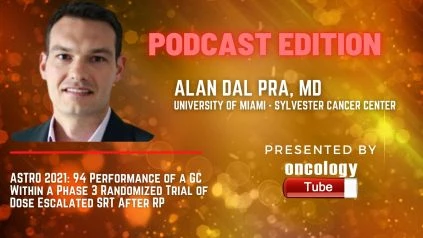Alan Dal Pra, MD from the University of Miami – Sylvester Cancer Center, Clinical Director, Director, Radiation Oncology Clinical Research Program speaks about ASTRO 2021 Abstract – 94 Performance of a Genomic Classifier (GC) Within a Phase 3 Randomized Trial of Dose Escalated Salvage Radiotherapy (SRT) After Radical Prostatectomy (RP).
Link to Abstract:
https://plan.core-apps.com/myastroapp2021/abstract/5dd0f31e-127e-4877-91e4-f2ff0571e5d5
– The body
Purpose/Objective(s):
PSA levels before salvage radiotherapy (SRT) and androgen deprivation therapy (ADT) are crucial prognostic and predictive factors after prostate surgery. GC has the ability to independently predict prostate cancer outcomes and may aid in the individualization of treatment. The role of the GC in patients treated in a recent phase 3 trial was investigated in this study.
Materials/Methods:
The SAKK 09/10 experiment (NCT01272050) is a multicenter, open-label, randomized phase 3 trial that took place at 24 centers across Switzerland, Germany, and Belgium. Patients with biochemical progression (PSA >0.1 to 2 ng/mL at randomization) were given either 64 or 70 Gy to the prostate bed. ADT or pelvic nodal radiation was not given to any of the patients. To investigate the impact of the GC on clinical outcomes, a pre-specified statistical plan was devised. The GC score range is 0 to 1, with locking cut points of 0.45-0.6, >0.6 for low, moderate, and high. Freedom from biochemical progression (FFBP) according to PSA at randomization (0.5 vs >0.5, a trial stratification variable) was the primary outcome in this sub-analysis. Age, T-category, Gleason score, persisting PSA after RP, and randomization arm were all taken into account in the Cox multivariable analysis (MVA). Clinical progression-free survival (CPFS) and time to salvage ADT were used as secondary goals.
Results:
One patient was ineligible and six patients failed QC out of 233 with tissue available. With a median follow-up of 6.3 years, the remaining 226 were included in the analysis (IQR 6.0-7.2). High- vs. low/intermediate-GC had HRs of 2.22 (95 percent CI 1.37-3.58, p=0.001) for FFBP, 2.29 (95 percent CI 1.32-3.98, p=0.003) for CPFS, and 2.99 (95 percent CI 1.50-5.95, p=0.002) for salvage ADT usage. The 5-year FFBP for low-intermediate GC was 74 percent [95 percent CI 66-82] in patients with PSA 0.5 ng/mL (165/226, 73 percent), compared to 59 percent [95 percent CI 43-74] in patients with high-GC. When SRT was administered at PSA >0.5 ng/mL, high-GC patients had a 5-year FFBP of 13 percent [95 percent CI 0-32], compared to 59 percent [95 percent CI 43-74] when PSA 0.5 ng/mL.
Conclusion:
Those with a high GC were more than twice as likely as patients with a low/intermediate GC to develop biochemical and clinical progression and receive salvage ADT in a recent phase 3 trial. By five years after SRT, high-GC individuals with PSA >0.5 ng/mL had a nearly 90% chance of recurrence. This research backs up the GC’s clinical value in personalizing treatment in the salvage context.

